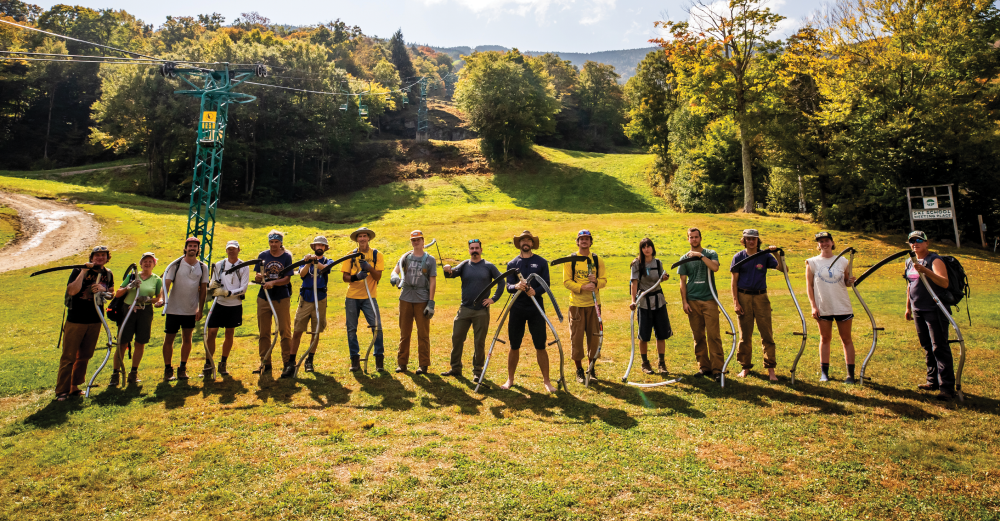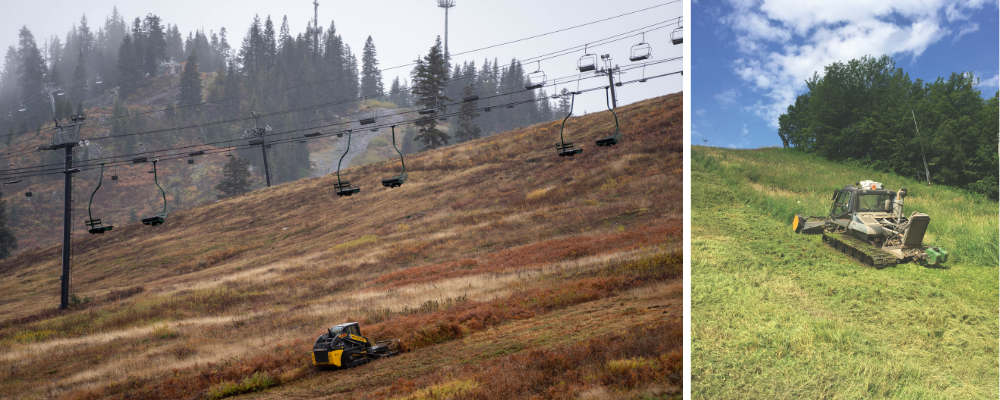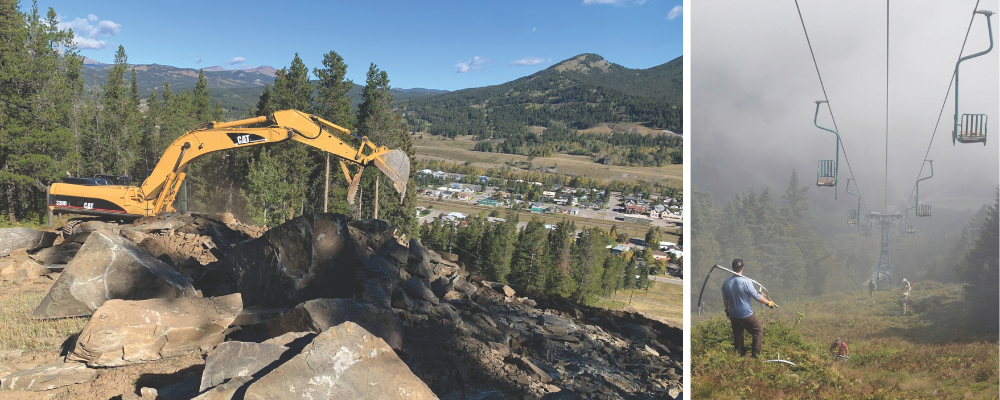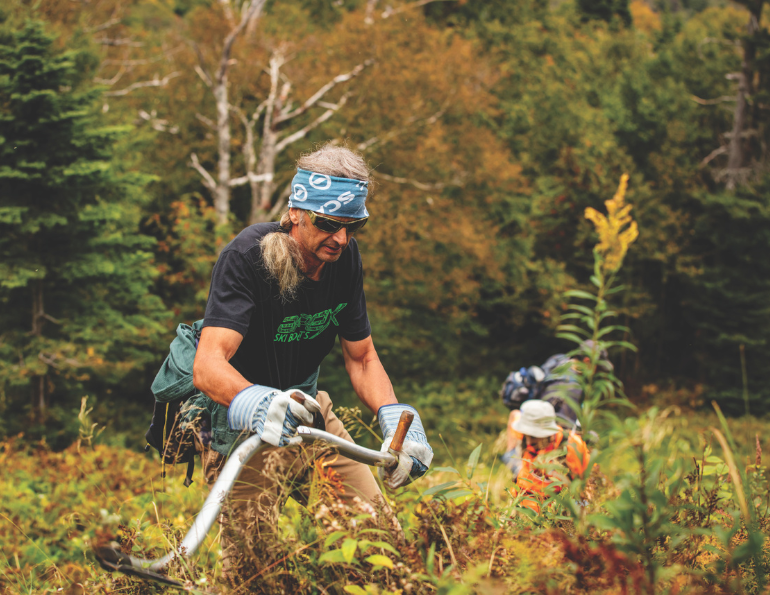In the last decade or so, no aspect of mountain operations has been more completely transformed by new technology than snow management. LiDAR mapping combined with sophisticated grooming software has enabled groomers to efficiently spread snow, man-made or natural, across a trail in an even blanket—not too deep here, not too shallow there. Low-e artillery has prompted dramatic recalculations of energy requirements. Automation has enabled snowmakers to make the most of diurnal temperature fluctuations. And so on.
But modern technology hasn’t eclipsed all methodology in achieving maximum efficiency in snow management, especially when there isn’t even snow on the hill. Summer trail preparations continue to rely largely on old-school practices, many predating snowmaking, and are critical in making maximal use of minimal early-season snow, man-made or natural.
Over the years, mountain ops teams have continually tweaked and refined the trail-prep process, but the basics—mowing and mulching, surface contouring, water management—haven’t changed dramatically.
The purpose: to open trails with far less snow coverage than if trails were left unattended. When it comes to snowmaking, being able to open trails with less snow is an obvious cost-saver. But whether on snowmaking or natural-snow trails, being able to extend the season by opening earlier (and staying open later) can be a revenue generator.
Old-School Trail Prep
Some trail-prep methodology continues to be downright quaint, as in the use of such yesteryear equipment as hand-held scythes. The image of a scythe-wielding team slashing its way down a mountain trail evokes a scene out of a van Gogh painting, a romanticization of pre-industrial labor.
Another pre-industrially quaint image comes from Katherine Seleski, now working for Castle Mountain in southern Alberta, but who was previously the general manager at Pass Powderkeg, a small neighboring ski area. Pass Powderkeg, she says, tried using goats to clear grass and brush, only to abandon the idea when negative interactions with bears became an issue.
Cutting by hand. The van Gogh scenario enters the trail-prep picture courtesy of Mad River Glen in Vermont, a ski area that has proudly built a national reputation on its old-school approach to just about every aspect of ski-area management. Snowmaking coverage is minimal, and on the few trails that do feature snowmaking, the trail-prep technology is a little more modern than the scything used on the rest of the mountain.
On trails too steep for safe use of a tractor (all of which are non-snowmaking trails), Mad River turns to a 10- to 20-person scythe team. (The ski area rewards the scythe team with a combination of pay and season passes.) One advantage of going the scythe route is that the configuration of a scythe allows the team to reach around the many subtle—and some not-so-subtle—contours and crevices that define Mad River’s famously challenging terrain.
As an alternative to coping with such unevenness, some areas might be inclined to blast rock or push around dirt to create a more even surface and perhaps enable mechanical mowing. But Mad River wouldn’t be Mad River if trail surfaces were all buffed smooth.
Cutting by machine. According to general manager Matt Lillard, Mad River has, since 2018, been using an Aebi slope tractor, a low-profile machine used at many resorts, to mow flatter trails. Before that, the ski area used a more traditional tractor with a brush cutter on the back, the kind of stuff that has been going on in Vermont land management since before there were ski areas. But the Aebi tractor, says Lillard, is able to cut “closer to the ground.” Of course, every inch of brush and grass cropped closer equates more or less to an inch less snow needed for skiable coverage.
 A team of 10 to 20 folks wield scythes on the Mad River Glen trails that can’t be mowed with the ski area’s Aebi slope tractor.
A team of 10 to 20 folks wield scythes on the Mad River Glen trails that can’t be mowed with the ski area’s Aebi slope tractor.
Mulching by Machine
Neighboring Sugarbush employs a similar combination of machine mowing and manual work, although with a slight uptick in technological modernity. Until recently, Sugarbush, like Mad River, had used a standard tractor with a brush-hog attachment to mow its lower-angled terrain. But it has since moved on to using a PistenBully 600 equipped with a Ski Hill Mulcher, a device that can be used with any snow groomer with a high-pressure hydrostatic drive. The new arrangement, says VP of mountain operations Pat Konvicka, is not only safer (tractors aren’t nearly as stable as groomers) but has also allowed the resort to mow terrain that had previously been too challenging (i.e., unsafe) for the tractor.
Nick Quail of the St. George Company, maker of the Ski Hill Mulcher, says that, depending on the terrain, the mulcher can reduce the grass height to a tightly cropped level equivalent to a golf-course fairway. For steeper trails, the mulcher can also operate on a winch cat.
The modern alternative to the scythe. Winching, however, is not the method Sugarbush chooses in reducing brush on its steeper trails. Instead, the resort hires a team from Horizons Forestry, a Virginia-based company that provides forestry and land-management services to both private and public entities. Like the scythe-wielders at Mad River, the Horizons team, more modernly equipped with hand-held motorized brush cutters, whacks its way down steeper terrain to reduce the trail brush and grass to an inches-high stubble.
In addition, Sugarbush has, unlike Mad River, done some trail contouring to smooth out rough spots and enable a more even distribution of snow. Konvicka says that the resort has used loaders and excavators to move dirt and grass to cover rock ledges, and is looking into more extensive contouring using a rock hammer.
Obviously, any resort needs to assess its character, or the character of any particular trail, to determine how much contouring is appropriate without impinging on the skier experience—uneven terrain can present challenges advanced skiers enjoy. The Sugarbush and Mad River contrast in the two areas’ approach to contouring is a good paradigm.
 Left to right: Mowing is just one component of off-season trail prep at The Summit at Snoqualmie; planning for water runoff is another; Depending on terrain, equipment like the Ski Hill Mulcher—a front-end attachment for snowcats—can trim trail grass to golf-course fairway height.
Left to right: Mowing is just one component of off-season trail prep at The Summit at Snoqualmie; planning for water runoff is another; Depending on terrain, equipment like the Ski Hill Mulcher—a front-end attachment for snowcats—can trim trail grass to golf-course fairway height.
Managing Runoff
Out on the West Coast, The Summit at Snoqualmie in Washington relies almost entirely on natural snow, so the resort does a lot of work to allow trails to open with minimal snow, and to keep the snow that falls—especially important as climate change puts a dent in The Summit’s average annual snowfall, which is about 420 inches since 1949-50, but has averaged 341 inches for the last 10 years. And its wet, maritime climate can make snow management a real challenge, according to the resort’s vice president of operations Justin Howard.
Managing water runoff is the biggest issue. The clearing, upgrading, and routing of diversionary infrastructure is a critical component of summer trail prep that aims to prevent water from wreaking havoc on the snowpack and to assure slope stability, summer and winter.
The Summit relies on water bars, lined with cobblestone, and, in some places, culverts and half culverts—culvert material cut in half and turned upside down, rainbow-style—to steer water away from places where it might do damage to skiing terrain.
Water, water issues everywhere. In fact, all of the mountain ops folks interviewed for this article agreed that drainage needs to be a high priority in the summer trail-prep process. It’s essential to ensure all water bars, ditches, and culverts are clear and properly directed, as well as make sure work roads are appropriately configured to drain properly. Nothing can destroy a snowpack more quickly and completely than water allowed to run its own course down a trail.
Like Sugarbush and Mad River, The Summit uses a combination of machine mowing and manual labor to reduce trail brush and grass. Howard says they deploy small skid-steer tractors, each with a 72-inch mowing deck, to shave lower-angle trails. These replaced an old Bombardier groomer with a 12-foot flail mower that Howard says was just too unwieldy. The resort also sends out a crew of six to eight paid employees, all members of the winter staff, to hit more rugged terrain with “weed whackers on steroids” and chainsaws.
It’s a summer-long process. The Summit’s trail work stretches from June into September, working around its downhill mountain bike trails. Resorts with very active summer-ops programs might need to be choosier about trail-maintenance schedules, not only to avoid disturbing summer guests but also to limit impacts on summer-ops infrastructure. Berms for mountain-bike trails, for example, can take a beating during mowing operations.
 Left to right: An earthwork project at Pass Powderkeg, Alberta, saved the ski area hundreds of snowmaking hours and added operating days; A scythe team preps Mad River Glen’s (Vt.) steeper trails for snow.
Left to right: An earthwork project at Pass Powderkeg, Alberta, saved the ski area hundreds of snowmaking hours and added operating days; A scythe team preps Mad River Glen’s (Vt.) steeper trails for snow.
The Payback
The bottom line with summer trail prep is, of course, the impact on the bottom line.
Cost savings is a big part of the justification for doing the work. Bigger projects, like the one Pass Powderkeg undertook a few years ago, start with identifying areas that cause the biggest headaches, “whether it was somewhere we had to make a ton of snow to make it safe or somewhere that just sucked to ski,” says Seleski, and working with an earthworks company to re-work the terrain and improve those problem areas. “It is amazing what one operator can do with a Cat D9 dozer,” she adds.
Seleski calculated that Pass Powderkeg’s earthwork project saved the ski area roughly 128 snowmaking hours, and Pass Powderkeg was able to open a week earlier than expected thanks to less snow being needed to safely open the terrain that first season. Cost savings on one end, additional revenue on the other.
Similarly, Sugarbush snowmaking manager Sean Patenaude says he has seen a steady decline in recent years in air generation and water output, due at least in part to summer trail work.
Longer season. The extension of the season and the additional revenue that generates may be the biggest payoff. Quail claims that use of the Ski Hill Mulcher can typically add a week to the beginning of the season and two weeks at the end. Howard at The Summit cites those same numbers—opening a week sooner, closing two weeks later—as the payoff of the resort’s trail prep efforts and snow management. Pass Powderkeg’s project showed immediate returns.
Snow management and snow-management technology continue to evolve, but in some cases, especially for summer trail prep, sticking with old-school practices might be the best methodology to put into play. Even Mad River’s pre-industrial scything.





